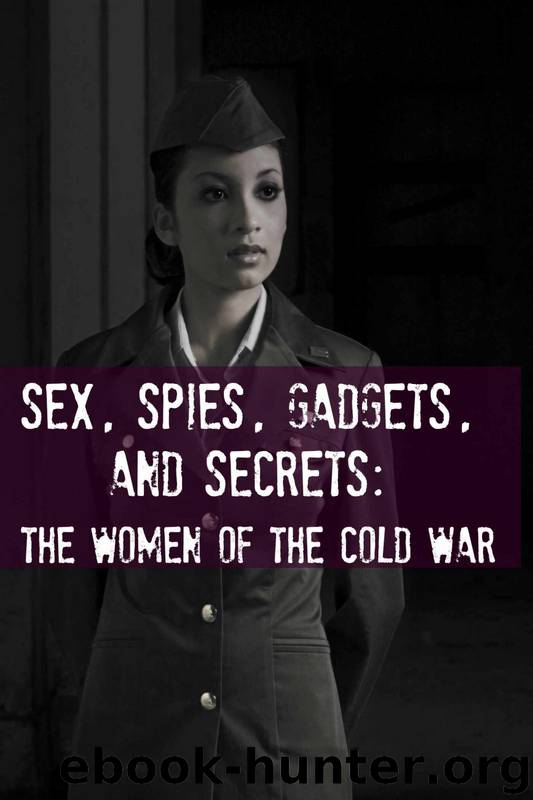Sex, Spies, Gadgets, and Secrets: The Women of the Cold War by GadChick

Author:GadChick
Language: eng
Format: mobi, azw3
Publisher: GadChick
Published: 2012-12-19T23:00:00+00:00
Juanita Moody
One post-WWII stereotype has Rosie the Riveter hanging up her work gloves after the fighting is over, cheerfully—or perhaps not-so-cheerfully—going back full-time to life on the household front as the men come marching home.
Fortunately for women today, not all the Rosies were ready to give up the excitement and intellectual stimulation that their wartime working lives had brought them. Many who had worked in intelligence stuck around and continued to use what they had learned, from cracking German and Japanese codes to deciphering Soviet communications.
Juanita Moody was one of the women who went from working during WWII to trying to make sense of a decidedly chillier conflict. She was a college student in North Carolina in 1943 when she decided to contribute to the war effort by volunteering at a recruiting office, according to the NSA’s Cryptologic Hall Of Honor website (www.nsa.gov/about/cryptologic_heritage/hall_of_honor/index.shtml). She found herself at the U.S. Army’s cryptologist headquarters, training in cryptanalysis through the Signal Security Agency. The subject soon entranced her.
By the end of the war, Moody was by no means ready to leave, and her supervisor asked her to stay on. She worked in NSA’s Signals Intelligence operations as the Cold War intensified, and before long the 1962 Cuban Missile Crisis loomed. “I think the Cuban Crisis experience in the (National Security) Agency allowed us to take advantage of everything that we had learned during World War II and post-World War I,” she later told the NSA.
During the crisis, Moody supervised NSA’s response, serving as “the head of the major element responsible for Signals Intelligence … on that region,” according to the Hall of Honor website. “In addition to directing production and reporting, she frequently gave impromptu briefings to high-level civilian and military leaders. She often worked around the clock, grabbing only a few hours’ sleep on a cot in her office.”
Moody also became a role model for women in SIGINT. (Today, SIGINT is directed by a woman, Teresa H. Shea.)
After the Cuban Missile Crisis, Moody stayed on with the NSA, continuing to revolutionize SIGINT reporting and ultimately getting NSA into the White House Situation Room, according to the website. By the 1970s, she was one of the NSA’s spokespeople during U.S. Congressional hearings, where she was “incorrectly identified by the media as having been involved in intelligence-community abuses.”
In 1975, (President) George H.W. Bush, then director of the CIA, presented Moody with the first National Intelligence Medal of Achievement. She retired the following year after 33 years with the NSA.
Download
Sex, Spies, Gadgets, and Secrets: The Women of the Cold War by GadChick.azw3
This site does not store any files on its server. We only index and link to content provided by other sites. Please contact the content providers to delete copyright contents if any and email us, we'll remove relevant links or contents immediately.
| Africa | Americas |
| Arctic & Antarctica | Asia |
| Australia & Oceania | Europe |
| Middle East | Russia |
| United States | World |
| Ancient Civilizations | Military |
| Historical Study & Educational Resources |
Cat's cradle by Kurt Vonnegut(14768)
Pimp by Iceberg Slim(13787)
Underground: A Human History of the Worlds Beneath Our Feet by Will Hunt(11843)
4 3 2 1: A Novel by Paul Auster(11800)
The Radium Girls by Kate Moore(11627)
Wiseguy by Nicholas Pileggi(5323)
American History Stories, Volume III (Yesterday's Classics) by Pratt Mara L(5139)
Perfect Rhythm by Jae(5076)
The Fire Next Time by James Baldwin(5024)
Paper Towns by Green John(4805)
Pale Blue Dot by Carl Sagan(4627)
A Higher Loyalty: Truth, Lies, and Leadership by James Comey(4557)
The Mayflower and the Pilgrims' New World by Nathaniel Philbrick(4285)
The Doomsday Machine by Daniel Ellsberg(4250)
Killers of the Flower Moon: The Osage Murders and the Birth of the FBI by David Grann(4192)
Too Much and Not the Mood by Durga Chew-Bose(4097)
The Sympathizer by Viet Thanh Nguyen(4096)
The Borden Murders by Sarah Miller(4025)
Sticky Fingers by Joe Hagan(3916)
